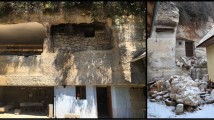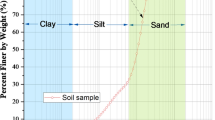Abstract
A procedure for the estimation of distribution parameters of a Weibull distribution model K 1 = f(K 12/4Ic /σ 23/4C ) for solid particle erosion, as recently suggested in Rock Mech Rock Eng, doi: 10.1007/s00603-014-0658-x, 2014, is derived. The procedure is based on examinations of elastic–plastically responding rocks (rhyolite, granite) and plastically responding rocks (limestone, schist). The types of response are quantified through SEM inspections of eroded surfaces. Quantitative numbers for the distribution parameter K 1 are calculated for 30 rock materials, which cover a wide range of mechanical properties. The ranking according to the parameter K 1 is related to qualitative rock classification schemes. A modified proposal for the erosion of schist due to solid particle impingement at normal incidence is introduced.







Similar content being viewed by others
Abbreviations
- b :
-
Distribution scale parameter
- C :
-
Target material flow stress parameter
- C P :
-
Specific heat target material
- e :
-
Coefficient of restitution
- E :
-
Effective modulus
- E R :
-
Relative erosion
- E LR :
-
Relative erosion due to lateral fracture
- E PR :
-
Relative erosion due to plastic deformation
- F :
-
Numerical constant
- H M :
-
Target material hardness
- K 1 :
-
Erosion function parameter
- K Ic :
-
Target material fracture toughness
- n :
-
Work hardening coefficient
- N i :
-
Number of eroded sections
- NL :
-
Number of sections related to lateral fracture
- N P :
-
Number of sections related to plastic deformation
- v P :
-
Erodent particle impact velocity
- α :
-
Erodent particle impact angle
- χ :
-
Transition parameter
- λ :
-
Distribution scale parameter
- ρ P :
-
Erodent material density
- σ C :
-
Target material compressive strength
References
Backers T (2004) Fracture toughness determination and micromechanics of rock under mode I and mode II loading. Dissertation, Universität Potsdam, Germany
Breder K, Giannakopoulos AE (1990) Erosive wear in Al2O3 exhibiting Mode-I R-curve behavior. Ceram Eng Sci Proc 11:1046–1060
Brown R, Jun EJ, Edington JW (1981) Erosion of α-Fe by spherical glass particles. Wear 70:347–363
Deere DU, Miller RP (1966) Engineering classification and index properties for intact rocks. Technical Report AFWL-TR-65-116, Air Force Weapons Laboratory, Kirtland, NM, USA
Dodson B (2006) The Weibull analysis handbook, 2nd edn. American Soc. for Quality, Milwaukee
Gotzmann J (1989) Modellierung des Strahlverschleißes an keramischen Werkstoffen. Schmierungstechnik 20:324–329
Heßling M (1988) Grundlagenuntersuchungen über das Schneiden von Gestein mit abrasiven Höchstdruckwasserstrahlen. Dissertation, RWTH Aachen, Germany
Hutchings IM (1981) A model for the erosion of metals by spherical particles at normal incidence. Wear 70:269–281
Hutchings IM (1992) Tribology: friction and wear of engineering materials. Edward Arnold, CRC Press, London
Kobayashi R, Matsuki K, Otsuka N (1986) Size effect in the fracture toughness of Ogino tuff. Int J Rock Mech Min Sci Geomech Abstr 23:13–18
Momber AW (2011) Fracture features in soda-lime glass after testing with a spherical indenter. J Mater Sci 46:4494–4508
Momber AW (2013) Erosion of schist due to solid particle impingement. Rock Mech Rock Eng 46:849–857
Momber AW (2014a) Fracture toughness effects in geomaterial solid particle erosion. Rock Mech Rock Eng. doi:10.1007/s00603-014-0658-x
Momber AW (2014b) Effects of target material properties on solid particle erosion of geomaterials at different impingement velocities. Wear 319:69–83
O’Flynn DJ, Bingley MS, Bradley A, Burnett AJ (2001) A model to predict the solid particle erosion rate of metals and its assessment using heat-treated steels. Wear 248:162–177
Rogers CO, Pang SS, Kumano A, Goldsmith W (1986) Response of dry- and liquid-filled porous rocks to static and dynamic loading by variously-shaped projectiles. Rock Mech 19:235–260
Sundararajan G (1991) A comprehensive model for the solid particle erosion of ductile materials. Wear 149:111–127
Sundararajan G, Shewmon P (1987) Oblique impact of a hard ball against ductile, semi-infinite target materials experiment and analysis. Int J Impact Eng 6:3–22
Verhoef PN (1987) Sandblast testing of rock. Int J Rock Mech Min Sci Geomech Abstr 24:185–192
Whittacker BN, Singh RN, Sun G (1992) Rock fracture mechanics: principles, design and applications. Elsevier, Amsterdam
Wiederhorn SM, Hockey BJ (1983) Effect of material parameters on the erosion resistance of brittle materials. J Mater Sci 18:766–780
Author information
Authors and Affiliations
Corresponding author
Rights and permissions
About this article
Cite this article
Momber, A.W. A Refined Model for Solid Particle Rock Erosion. Rock Mech Rock Eng 49, 467–475 (2016). https://doi.org/10.1007/s00603-015-0745-7
Received:
Accepted:
Published:
Issue Date:
DOI: https://doi.org/10.1007/s00603-015-0745-7




